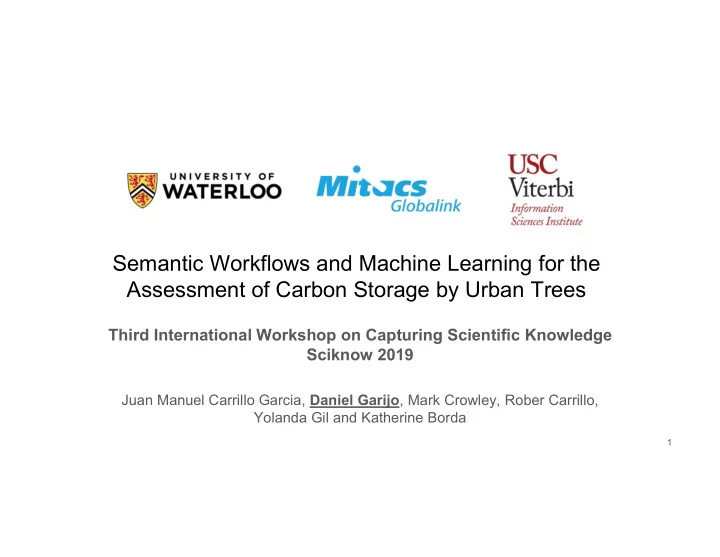

Semantic Workflows and Machine Learning for the Assessment of Carbon Storage by Urban Trees Third International Workshop on Capturing Scientific Knowledge Sciknow 2019 Juan Manuel Carrillo Garcia, Daniel Garijo , Mark Crowley, Rober Carrillo, Yolanda Gil and Katherine Borda 1
Introduction Research in Climate Science Therefore, it can benefit from best practices in ● Highly complex, nonlinear dynamics ● Data Provenance ● Disparate spatial and temporal scales ● Software interoperability and reusability ● Multidisciplinary teams ● Reproducibility of experiments The ultimate goal is to improve Knowledge sharing, and Semantic workflows contribute significantly 2
Introduction The study of Carbon emissions and storage is key in Climate Science. 3
Introduction ● Carbon storage by urban trees , in the form of biomass, is fundamental to mitigate emissions. ● The IPCC provides guidelines for the assessment of carbon stored in trees. ● However, each country determines the implementation details. Major Carbon Fluxes of North America. Units are in teragrams of carbon (Tg C) per Year. Source: carbon2018.globalchange.gov 4
Scientific workflow design The workflow is designed as multiple interconnected components in WINGS that operate in three consecutive stages. The components in stages one and two are also useful for other applications. 5
Area of study and data City of Juba in South Sudan. ● Capital and main hub for commerce and transportation. ● Population is nearly 386,000 Some current issues ● Political instability ● Poor health services ● Lack of infrastructure 6
Area of study and data 7
Implementation and results Workflow fragment Workflow fragment for for data preparation mapping tree cover Conversion of file Split sample points in formats 80% for training and 20% for validation. Transform coordinate system Crop satellite image to area of interest Prepare file for assignment of labels Training of Random Forest image classifier 8
Implementation and results Normalized confusion matrix - Resulting land cover map for the city of Juba Classification with Random Forest IPCC carbon removal factor of 2.9 tonnes of Carbon per hectare of crown cover per year. Trees in the city of Juba remove 30,506 tonnes of Carbon per year, roughly the emissions from 6632 buses . 9
Conclusions and future work ● We introduce a library of workflow components to perform spatial data transformations, land cover mapping and assessment of carbon storage. ● We use scientific workflows to increase reusability of software components, reproducibility, and transparency of carbon assessment studies. ● Future work will focus on implementation for other locations around the globe and calibration of parameters to improve accuracy. 10
Complementary slides... 11
Outline ● Introduction ● Scientific workflow design ● Area of study and data ● Implementation and results ● Conclusions and future work 12
Land cover for the assessment of Carbon storage WINGS Workflow Prepare training samples Prepare Land cover satellite image Image classification 13
Land cover for the assessment of Carbon storage Original Sentinel-2 image Land cover 14 km 110 km Workflow 14
Example data preparation Geospatial ETL (Extract Transform Load) Preparing a Digital Elevation Model DEM ● Convert file formats ● Reproject to a local coordinate system ● Combine multiple DEMs ● Filter polygon of interest from provinces ● Cut to an area of interest 15 Image source: https://www.earthdatascience.org/courses/earth-analytics/spatial-data-r/geographic-vs-projected-coordinate-reference- systems-UTM/
Preparation of DEM Geospatial ETL (Extract Transform Load) Implemented as components in WINGS that can be reused for other models Using GDAL Image source: https://gdal.org/index.html 16
Software Data preparation Machine Learning Geospatial Data Orfeo ToolBox (OTB) Abstraction Library orfeo-toolbox.org gdal.org 17
Recommend
More recommend